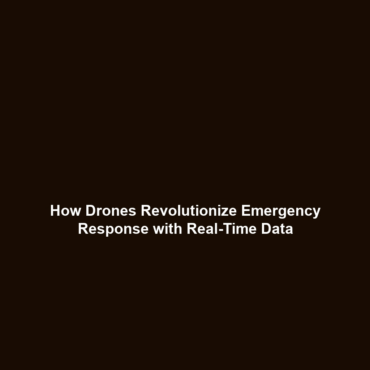Drones Providing Real-Time Imagery and Data to Guide Emergency Response Efforts
Drones have emerged as crucial tools in various fields, transforming our approach to scientific inquiry and practical applications. In particular, drones providing real-time imagery and data are significantly enhancing emergency response efforts. These advancements facilitate faster decision-making and efficient resource management during crises such as natural disasters, accidents, and humanitarian emergencies. This article discusses the implications of such technology within the broader context of Drones in Science, emphasizing its role in saving lives and improving outcomes in emergency scenarios.
Key Concepts
The following key concepts outline the principles surrounding how drones are utilized in emergency response:
- Real-Time Data Collection: Drones are equipped with advanced sensors and cameras that capture real-time imagery, offering immediate insights into crisis situations.
- Geospatial Analysis: The data collected can be processed to produce accurate maps and 3D models, critical for strategic planning in response efforts.
- Rapid Deployment: With the ability to be deployed quickly from diverse locations, drones can reach areas that are difficult for ground teams to access promptly.
This technology is not only revolutionizing emergency response but also exemplifies the broader category of Drones in Science, showcasing their multifaceted applications in research, environmental monitoring, and public safety.
Applications and Real-World Uses
Drones providing real-time imagery and data are being utilized in various real-world applications that underscore their impact on emergency response:
- Natural Disaster Management: During hurricanes, earthquakes, or floods, drones are deployed to assess damage, monitor changes in real-time, and inform rescue operations.
- Search and Rescue Operations: Drones equipped with thermal imaging cameras can locate missing persons in challenging environments, such as dense forests or mountain ranges.
- Public Health Surveillance: Drones have been used in outbreak responses, providing imagery to track the spread of diseases and facilitate efficient medical resource allocation.
These applications exemplify how drones providing real-time imagery are vital in guiding emergency response efforts in the field of Drones in Science.
Current Challenges
Despite their significant advantages, the use of drones in emergency response also faces various challenges, including:
- Regulatory Restrictions: Airspace regulations limit drone usage, often delaying response times.
- Technical Limitations: Factors like battery life, data transmission range, and sensor capabilities can hinder effectiveness.
- Privacy Concerns: The use of drones raises ethical issues around surveillance and personal privacy.
- Operational Training: Effective use of drone technology requires trained personnel, which can be a barrier in some regions.
These challenges highlight the complexities and considerations inherent in the challenges of drones providing real-time imagery and their role in emergency response.
Future Research and Innovations
The future of drones in guiding emergency response is promising, with several innovations on the horizon:
- Improved AI Technology: Next-gen drones are expected to utilize artificial intelligence to process data in real-time, enhancing decision-making capabilities.
- Swarming Technologies: Research into swarming multiple drones offers the potential for extensive coverage and data collection during emergencies.
- Enhanced Sensor Technology: Advancements in sensors will improve data accuracy, enabling more effective responses during crises.
These innovations signify a transformative shift in how drones providing real-time imagery will continue to impact Drones in Science and emergency response in the future.
Conclusion
In conclusion, drones providing real-time imagery and data are redefining emergency response efforts, demonstrating their critical value within the sphere of Drones in Science. While challenges persist, the potential for future advancements and applications holds great promise for enhancing public safety and emergency management. To learn more about how technology is shaping our world, explore other articles in our Drones in Science series.

Leave a Reply